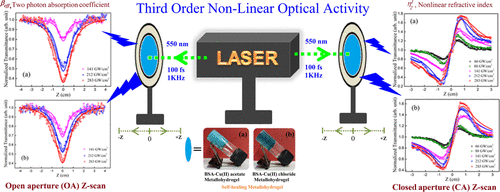当前位置:
X-MOL 学术
›
ACS Appl. Electron. Mater.
›
论文详情
Our official English website, www.x-mol.net, welcomes your
feedback! (Note: you will need to create a separate account there.)
Protein-Based Self-Healing Cu(II)-Metallohydrogels: Efficient Third-Order Nonlinear Optical Materials in Terms of an Intensity-Dependent Refractive Index and Two-Photon Absorption
ACS Applied Electronic Materials ( IF 4.3 ) Pub Date : 2020-11-09 , DOI: 10.1021/acsaelm.0c00728 Santanu Majumdar 1 , Tara Singha 2 , Subhendu Dhibar 1 , Amit Mandal 3 , Prasanta Kumar Datta 2 , Biswajit Dey 1
ACS Applied Electronic Materials ( IF 4.3 ) Pub Date : 2020-11-09 , DOI: 10.1021/acsaelm.0c00728 Santanu Majumdar 1 , Tara Singha 2 , Subhendu Dhibar 1 , Amit Mandal 3 , Prasanta Kumar Datta 2 , Biswajit Dey 1
Affiliation

|
Two protein-based self-healing Cu(II)-metallohydrogels named BSA-CuA and BSA-CuCl have been synthesized by mixing acetate and chloride salts of Cu(II) distinctly with the protein bovine serum albumin (BSA) in water medium. Experimentally investigated rheological parameters of both synthesized metallohydrogels not only expose the viscoelastic semi solid nature and mechanical toughness but also reveal the self-healing properties of both metallohydrogel materials. Counteranion-directed morphological variations of these metallohydrogels are visualized through field-emission scanning electron microscopic images. The third-order optical nonlinear susceptibility x(3) of these synthesized metallohydrogels has been studied using the Z-scan technique at a wavelength of 550 nm under the femtosecond regime in the excitation intensity range from 66 to 283 GW/cm2. BSA-CuA and BSA-CuCl metallohydrogels exhibit a high value of the positive nonlinear refractive index n2I and two-photon absorption coefficient βeff, which are very important for all-optical switching, optical limiting, and other photonic applications. The polarity possibly associated with the self-healing property of these two synthesized metallohydrogels has been justified through the experimentally measured high value of optical nonlinearity. At 88 GW/cm2 intensity of the excitation beam, the n2I values for BSA-CuA and BSA-CuCl are (14.40 ± 0.16) × 10–7 cm2/GW and (10.99 ± 0.15) × 10–7 cm2/GW, respectively, and at 283 GW/cm2 intensity, the βeff values are (0.0662 ± 0.0002) cm/GW and (0.0540 ± 0.0001) cm/GW, respectively. The (x(3)) of BSA@CuA and BSA@CuCl at 283 GW/cm2 is (1.757 ± 0.018) (esu ×10–14) and (1.560 ± 0.017) (esu ×10–14), respectively.
中文翻译:

基于蛋白质的自修复Cu(II)-金属水凝胶:高效的三阶非线性光学材料的强度依赖性折射率和双光子吸收
通过将Cu(II)的乙酸盐和氯化物盐与蛋白质牛血清白蛋白(BSA)分别在水介质中混合,合成了两种基于蛋白质的自修复Cu(II)-金属水凝胶BSA-CuA和BSA-CuCl。实验研究了两种合成金属水凝胶的流变参数,它们不仅揭示了粘弹性的半固体性质和机械韧性,而且揭示了两种金属水凝胶材料的自修复性能。通过场发射扫描电子显微镜图像可以看到这些金属水凝胶的负离子定向形态变化。三阶光学非线性磁化率x (3)已经使用Z扫描技术在飞秒范围内在550nm的波长下在66至283GW / cm 2的激发强度范围内研究了这些合成的金属水凝胶。BSA-CuA和BSA-CuCl金属水凝胶显示出高的正非线性折射率n 2 I和双光子吸收系数βeff,这对于全光切换,光限制和其他光子应用非常重要。通过实验测量的高光学非线性值,已经证明了可能与这两种合成的金属水凝胶的自愈特性相关的极性。在激发光束强度为88 GW / cm 2时,n在283 GW / cm 2的强度下,BSA-CuA和BSA-CuCl的2 I值分别为(14.40±0.16)×10 –7 cm 2 / GW和(10.99±0.15)×10 –7 cm 2 / GW中,β EFF值(0.0662±0.0002)厘米/ GW和(0.0540±0.0001)厘米/ GW,分别。BSA @ CuA和BSA @ CuCl在283 GW / cm 2的(x (3))分别为(1.757±0.018)(esu×10 –14)和(1.560±0.017)(esu×10 –14)。
更新日期:2020-11-09
中文翻译:

基于蛋白质的自修复Cu(II)-金属水凝胶:高效的三阶非线性光学材料的强度依赖性折射率和双光子吸收
通过将Cu(II)的乙酸盐和氯化物盐与蛋白质牛血清白蛋白(BSA)分别在水介质中混合,合成了两种基于蛋白质的自修复Cu(II)-金属水凝胶BSA-CuA和BSA-CuCl。实验研究了两种合成金属水凝胶的流变参数,它们不仅揭示了粘弹性的半固体性质和机械韧性,而且揭示了两种金属水凝胶材料的自修复性能。通过场发射扫描电子显微镜图像可以看到这些金属水凝胶的负离子定向形态变化。三阶光学非线性磁化率x (3)已经使用Z扫描技术在飞秒范围内在550nm的波长下在66至283GW / cm 2的激发强度范围内研究了这些合成的金属水凝胶。BSA-CuA和BSA-CuCl金属水凝胶显示出高的正非线性折射率n 2 I和双光子吸收系数βeff,这对于全光切换,光限制和其他光子应用非常重要。通过实验测量的高光学非线性值,已经证明了可能与这两种合成的金属水凝胶的自愈特性相关的极性。在激发光束强度为88 GW / cm 2时,n在283 GW / cm 2的强度下,BSA-CuA和BSA-CuCl的2 I值分别为(14.40±0.16)×10 –7 cm 2 / GW和(10.99±0.15)×10 –7 cm 2 / GW中,β EFF值(0.0662±0.0002)厘米/ GW和(0.0540±0.0001)厘米/ GW,分别。BSA @ CuA和BSA @ CuCl在283 GW / cm 2的(x (3))分别为(1.757±0.018)(esu×10 –14)和(1.560±0.017)(esu×10 –14)。









































 京公网安备 11010802027423号
京公网安备 11010802027423号